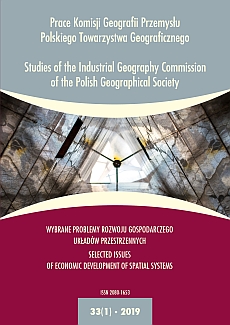Effects of Natural Geographic Features on the Manufacturing Industry in Sanliurfa, Turkey
DOI:
https://doi.org/10.24917/20801653.331.7Keywords:
geography, industry, natural environment, Sanliurfa, TurkeyAbstract
Geographical features of a place have an important effect on distribution, location, aglomeration and a variety of industrial activities. Social and economical features, along with natural geographic features such as geology, geomorphology, climate, natural vegetation, soil properties and hydrographic features also have a significant effect on industry. This study aims at determining how physical geographic features affect categories of industrial activities in Sanliurfa. For this purpose, firstly, physical geographic features of Sanliurfa and statistical data on agricultural and industrial activities in Sanliurfa were obtained. Then, effects of these physical features on other economic activities and the influence of those features on the distribution of industrial plants and industrial activities were analysed in terms of distribution, relation and casuality principles. Geological formations in Sanliurfa province occured in Neogene and also in Quaternary. These formations mostly consist of Neogene limestone, Quaternary basaltic volcanic rocks and alluvial soils. Geomorfically Sanliurfa is a slightly hilly place with plateaus and plains. The main river in Sanliurfa is the Euphrates - the biggest river of Turkey. Naural vegatation of Sanliurfa consists of steppe. These physical geographic fetaures of Sanliurfa cause intensive agricultural activites all across the province. Sanliurfa province covers 18,584 km² and 60% of this area is convenient for agriculture. As a consequence, the majority of manucturing industry in Sanliurfa is agro-based, such as food, textile, mill and apparel industries. While these categories constitute 65.43% of all industrial enterprises, the share of enterprises involving stone, clay, glass, and concrete industry is 11%, and lumber and wood industry share is only 2%.
Downloads
Metrics
References
Aral, I.O. (2008). Geology of Turkey: A synopsis. Anschnitt, 21, 19–42.
Benek, B., Şahinalp, M.S., Elmastaş, N. (2008). Şanlıurfa ilinde sulama tesislerinin arazi kullanımı bakımından yarattığı sorunlar. V. Ulusal Coğrafya Sempozyumu. 5th National Geography Symposium. Ankara (16–17 October 2008), 61–70.
Canfei, H., Shengjun, Z. (2017). Industrial geography. In: D. Richardson et al. (eds.). International Encyclopedia of Geography, John Wiley & Sons, Ltd. DOI: 10.1002/9781118786352.wbieg04.
Industrial Geography | Request PDF. Retrieved from:https://www.researchgate.net/publication/ 307906868_Industrial_Geography, (2018/10/17, 1–13).
Chenier, P.J. (2002). Introduction to the chemical industry: An overview. In: Survey of Industrial Chemistry. Topics in applied chemistry. Boston: Springer, 1–22.
Doğanay, H. (1995). Türkiye ekonomik coğrafyası. İstanbul: Öz Eğitim Yayınları.
Eker, İ., Koyuncu, M., Akan, H. (2008). The geophytic flora of Sanliurfa province, Turkey. Turkish Journal of Botany, 32, 367–38.
Ercan, T., Fujitani, T., Matsuda, J., Notsu, K., Tokel, S., Ui, T. (1990). Doğu ve güneydoğu Anadolu neojen-kuvaterner volkanitlerine ilişkin yeni jeokimyasal, radyometrik ve izotopik verilerin yorumu. MTA Dergisi, 110, 143–164.
Günal, V., Şahinalp, M.S. (2017). Coğrafi yapı ve tabiatın sunduklarıyla Şanlıurfa. In: M. Eriş, (ed.). Şanlıurfa. Şanlıurfa Valiliği Yayınları, 17–34.
Gürel, N., Teoman, M.Ş., Potoğlu, S., Ünsal, Y., Akbulut, İ., Turan, Y. (2000). Şanlıurfa ili yakın çevresinin arazi kullanım potansiyeli haritası projesi. Ankara: MTA Jeoloji Etütleri Dairesi.
İmamoğlu, M.Ş., Çetin, E. (2007). Güneydoğu Anadolu bölgesi ve yakın yöresinin depremselliği. D.Ü.Ziya Gökalp Eğitim Fakültesi Dergisi, 9, 93–103.
Kümmel, R. (2007). The productive of energy and its taxation. 4th European Congress Economy and Managers of Energy in Industry. Porto, Portugal, 27–30 November.
Mesubi, A.M. (2008). Chemical industry: An index of the technological development of a nation.
Public Lecture Series, 19(19). Ota, Ogun State, Nigeria: Covenant University Press ISSN 2006- --0327.
Mill, J.S. (1909). Principles of political economy. W.J. Ashley (ed.). London: Longmans.
Oldaç, T.Y., Eren, A., Türkman, M., Ertük, A. (1972). Harran ovası hidrojeolojik etüt raporu. Ankara: Enerji ve Tabii Kaynaklar Bakanlığı, Devlet Su İşleri Genel Müdürlüğü.
Pamukçu, O., Gönenç, T., Yurdakul Çirmik, A., Demirbaş, Ş., Tosun, S. (2015). Vertical and horizontal analysis of crustal structure in eastern Anatolia region. Bulletin of the Mineral Research and Exploration, 151, 217–229.
Parkin, M., Esquivel, G. (1999). Macroeconomía (in Spanish) (5th ed.). Mexico: Addison Wesley. ISBN 968-444-441-9.
Ricardo, D. (1951). On the principles of political economy and taxation. Cambridge: Cambridge University Press.
Samuelson, P.A., Nordhaus, W.D. (2009). Economics. 19th ed. New York: The McGraw-Hill Companies, Inc. ISBN 978-0-07-351129-0.
Seyitoğlu, G., Esat, K., Kaypak, B. (2017). The neotectonics of southeast Turkey, northern Syria, and Iraq: The internal structure of the southeast Anatolian wedge and its relationship with recent earthquakes. Turkish Journal of Earth Sciences, 26, 105–126.
Tardu, Y., Başkurt, T., Güven, A., Dinçer, A., Tuna, M.E., Tezcan, Ü.Ş. (1987). Akçakale grabeninin yapısal-stratigrafik özellikleri ve petrol potansiyeli. Türkiye 7. Petrol Kongresi Tebliğleri, 6–10 April, Ankara, 36–48.
Tümertekin, E., Özgüç, H. (1995). Ekonomik coğrafya. İstanbul: Çantay Kitabevi.
Zohary, M. (1973). Geobotanical foundations of the Middle East. 1–2. Stuttgart: Gustov Fisher Verlag.
Downloads
Published
How to Cite
Issue
Section
License
Articles are published under the terms of the Creative Commons License (CC BY-ND 4.0; Attribution– NoDerivs).

